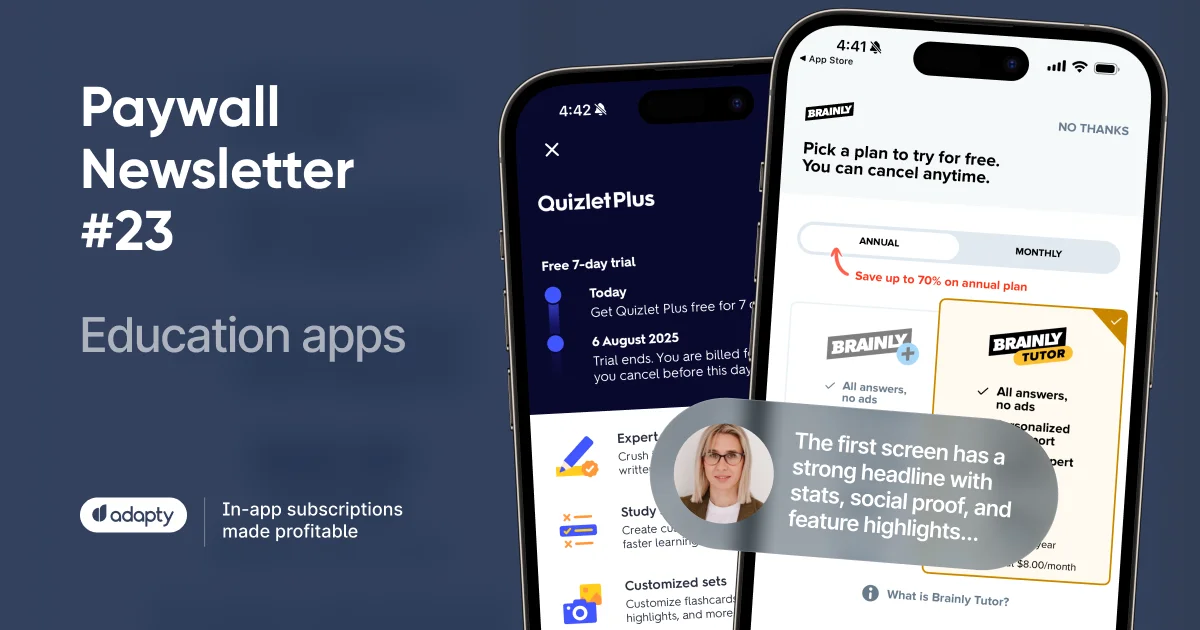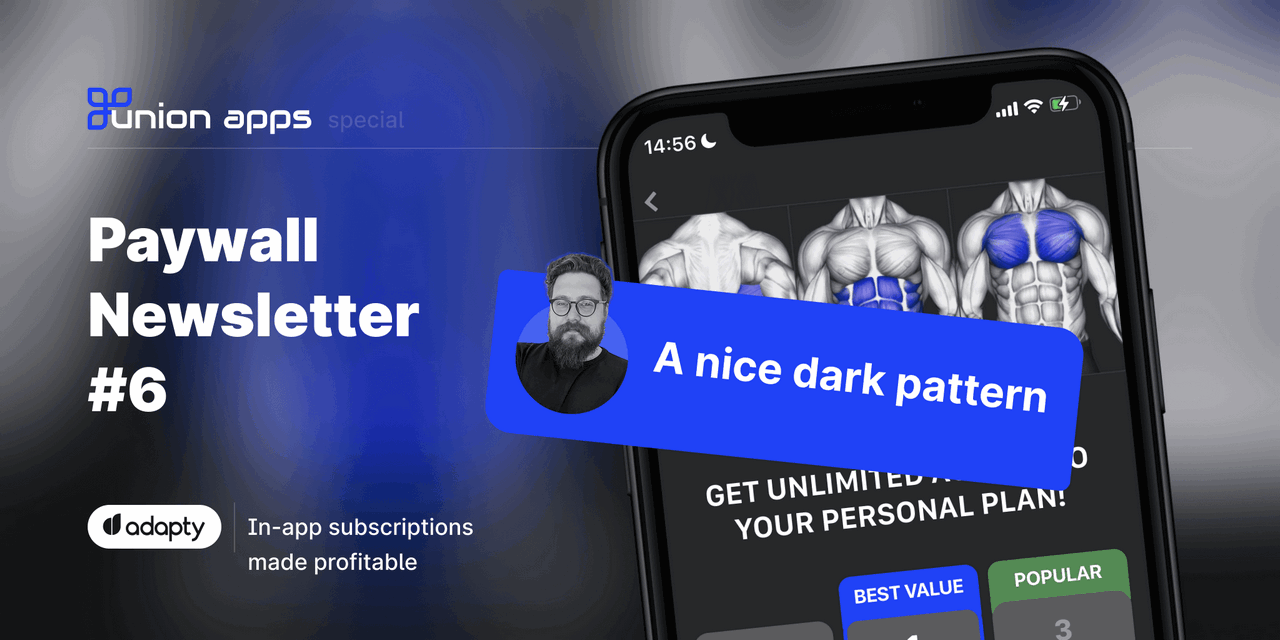In this issue of the Paywall Newsletter, we provide insights for paywalls from our latest “State of In-App Subscriptions in the US 2023” report based on 30M transactions. Today’s expert shares her own experience of which paywalls convert better.

Paywalls of this issue are commented on by…
Lucrezia Platé, Product & Growth Advisor in the mobile app space helping publishers grow their revenue through product and paywall optimization. Ex-Bending Spoons, a leading publisher in the mobile app industry.
The most profitable paywall is a combination of 3 products

Giving the user three options is generally the best-performing strategy, and it has been proven to increase conversion rates across industries.
This is essentially for two reasons:
Paradox of choice: If offered one option, we can choose whether to go for it or not. However, if we are offered two or more alternatives, our brain automatically starts choosing between those and tends to forget that “not choosing” is actually another potential option.
Decoy effect: Presenting a relatively unattractive third option (for example due to the higher price) increases the perceived value of the other two.

An important caveat is to make sure that the LTV doesn’t go down as you increase the number of products on your paywall. In order to do so, test pre-selecting the highest-LTV SKU on your paywall, or bundling it with a trial option (3-day or 7-day trial, no more).
Busuu
If you want to offer one product, go with weekly or lifetime
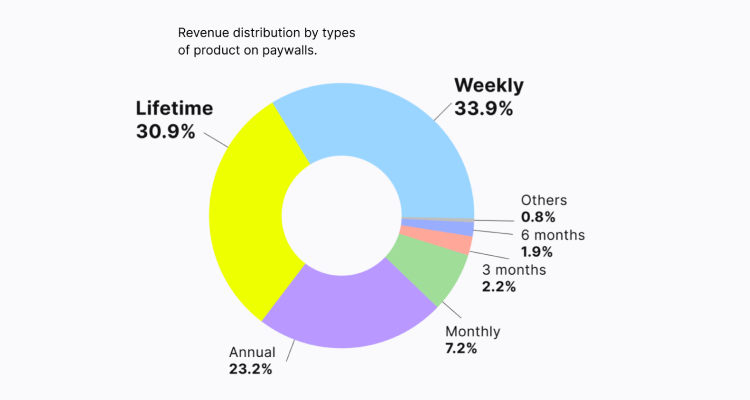
If you want to go for just one product, then you should first test subscriptions, keeping lifetime as a secondary option.
The data shown in the chart are probably affected by a sort of “availability bias”: in fact, most paid apps feature at least one offer between Lifetime, Weekly, and Yearly, while fewer include a 3-month or 6-month subscription in their paywalls. As a result, Weekly, Lifetime, and Annual result in a higher revenue portion.

Weekly subscriptions are generally suited to the vast majority of apps, in particular those that can be used on a daily basis. Plus, shorter durations are seen as low-risk options by the user. They are ideal to get started if you don’t need to cash out immediately, as they provide a more or less regular flow of cash and are usually the highest LTV option. However, I wouldn’t apply the weekly subscription model automatically, but first assess whether it is in line with the nature of the product: for a period-tracking app the yearly option could be the best choice instead.
When it comes to longer durations, their appeal comes from showing a large discount relative to the weekly/monthly offer. If you opt for just one product you don’t have this comparison advantage, so it’s best to stick with the weekly or yearly option based on the nature of your product.
Lifetime offers are ideal if you need to cash out immediately, although the LTV is generally lower. If you are transitioning from a free or soft monetization model, I would not suggest starting with the lifetime offer, but I would rather test subscriptions through a hard paywall, to assess their viability, and test the lifetime offer as a back-up plan.
Always sell annual + monthly/weekly when selling two products


When offering more than one product, a good choice is to go for the offers that can be easily compared by the user. Lifetime is not easily compared with a subscription, so it is preferable to test it as a fall-back option in a separate paywall or at least in a three-option paywall, but not as the only term of comparison.
As for subscription durations, Weekly or Monthly + Annual seems the best combination as the Annual option can be offered at a big discount relative to the lower periodicity. A well-known industry trick is to price your annual plan a bit higher than your LTV for monthly users: if your users stay on your app for an average of 4 months, then your annual plan should be priced at 5 months.
Always sell annual + monthly when selling three products
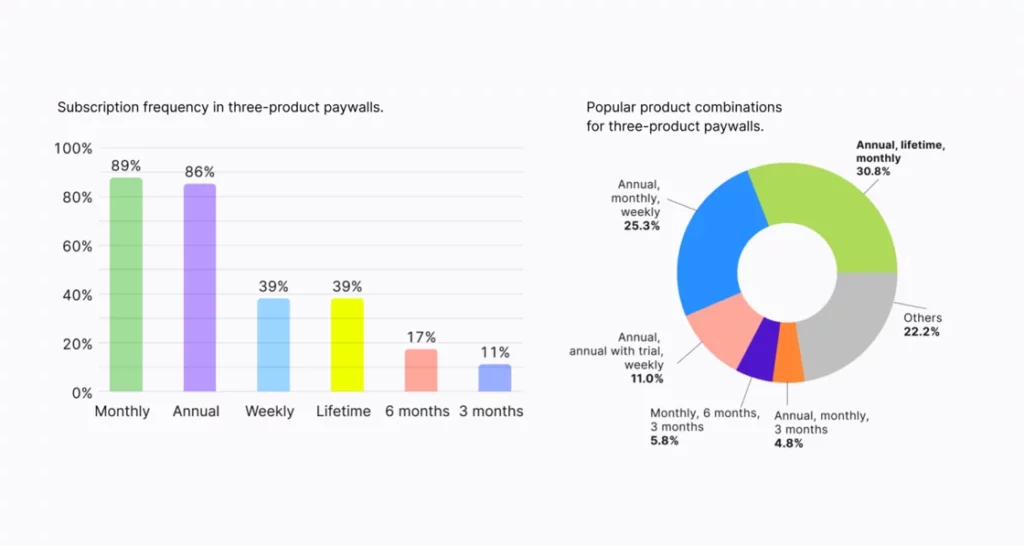
Presenting three products on your paywall allows you to exploit the decoy effect and give more prominence to the highest LTV option.
If we look at the data, we see that the most popular combinations are:
– Monthly, Annual, Lifetime,
– Weekly, Monthly, Annual.
To improve the positive effects, you could test the order in which your choices are displayed to the user, as this can influence their perception of value.

Priming your users with the highest-priced option can dramatically increase their willingness to pay, making the second option they see much more convenient (the so-called “anchoring effect”). This can be done by placing the highest-priced package first at the top – if you use a stacked pricing layout – or first on the left if you use a column layout and you target countries that read left-to-right.
Teams who experiment make up to 100x more revenue
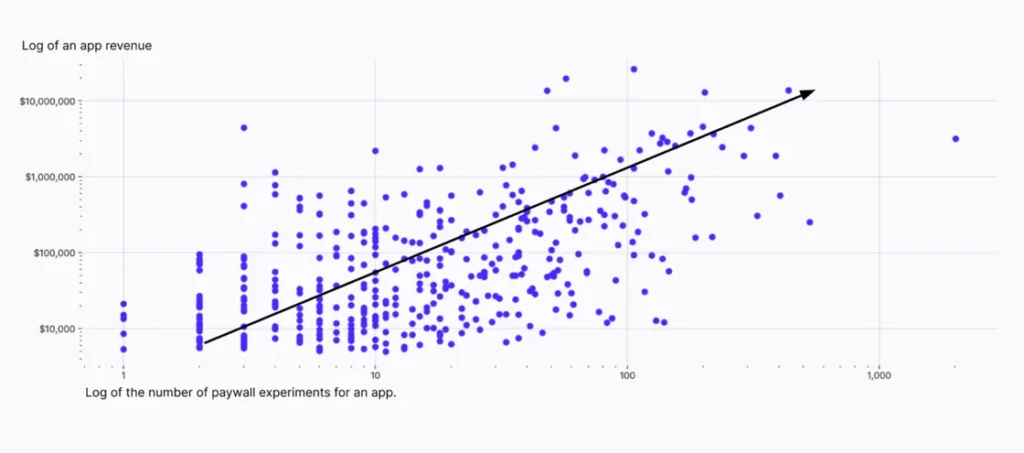
For quantitative testing to be effective, two conditions should be present:
- The traffic volume should be enough for tests to be statistically significant.
- The changes tested should be big enough to warrant a sizeable impact.
So, the amount of tests that can be carried out within a certain period varies depending on the number of daily installs of your app. This is to say that the results of this regression should be taken with a grain of salt, as the model doesn’t control for the number of users/installs. In other words, bigger apps with a larger amount of users are able to carry out more experiments, and they also get higher revenue, but that higher revenue might be due to both the bigger number of users and the number of experiments they run. It’s not easy to tell these two factors apart in the regression, as there is a “confounder” (the number of users/installs) that isn’t taken into account.
In any case, the positive results of adopting A/B testing and experimentation are unquestionable, and for sure the faster you iterate, the faster you can improve your business metrics. This is even more true when tests are done on paywalls, where the potential impact is higher.
If you wonder how it is possible to run so many tests on a paywall, consider that there are several aspects on which you could iterate:
- Placement, including contextualizing your paywall based on trigger points
- Pricing: number of options, discounts, position of the price on paywall
- Features, both in terms of features locked behind the paywall and features advertised on the paywall
- Visuals: Videos vs. static images, cards vs. carousel, etc.
- Copy.

Busuu


